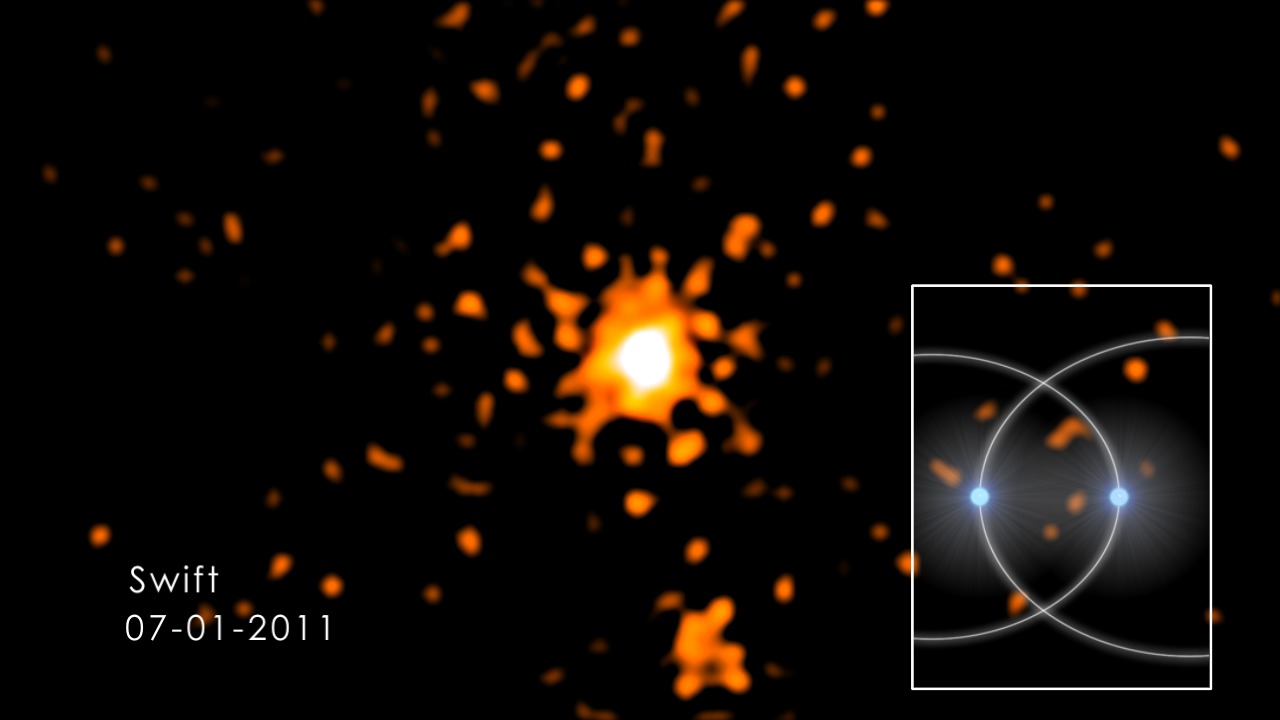Gamma rays in the Heart of Cygnus
Located in the vicinity of the second-magnitude star Gamma Cygni, the Cygnus X star-forming region was discovered as a diffuse radio source by surveys in the 1950s. Now, a study using data from NASA's Fermi Gamma-ray Space Telescope finds that the tumult of star birth and death in Cygnus X has managed to corral fast-moving particles called cosmic rays.
Cosmic rays are subatomic particles — mainly protons — that move through space at nearly the speed of light. In their journey across the galaxy, the particles are deflected by magnetic fields, which scramble their paths and make it impossible to backtrack the particles to their sources. Yet when cosmic rays collide with interstellar gas, they produce gamma rays — the most energetic and penetrating form of light — that travel to us straight from the source.
The Cygnus X star factory is located about 4,500 light-years away and is believed to contain enough raw material to make two million stars like our sun. Within it are many young star clusters and several sprawling groups of related O- and B-type stars, called OB associations. One, called Cygnus OB2, contains 65 O stars — the most massive, luminous and hottest type — and nearly 500 B stars. These massive stars possess intense outflows that clear out cavities in the region's gas clouds. A tangled web of shockwaves associated with this process impedes the movement of cosmic rays throughout the region. Cosmic rays striking gas nuclei or photons from starlight produce the gamma rays Fermi detects.
The release on NASA.gov is here.
Tour the Cygnus X star factory. This video opens with wide optical and infrared images of the constellation Cygnus, then zooms into the Cygnus X region using radio, infrared and gamma-ray images. Fermi LAT shows that gamma rays fill cavities in the star-forming clouds. The emission occurs when fast-moving cosmic rays strike hot gas and starlight.
Watch this video on the NASAexplorer YouTube channel.

Wide-field optical view of the Cygnus region.
Credit: Axel Mellinger, Central Michigan University

This image combines observations at radio wavelengths (74 and 21 cm, colored rose and green, respectively) with data from the Infrared Astronomical Satellite (60 and 25 microns, shaded turquoise and blue, respectively). The expanding shell of the Gamma Cygni supernova remnant, about 80 light-years across, stands out clearly in the radio data as a ruffled brown disk (upper right). White knots reveal the presence of newly formed stars embedded in dense gas. Diffuse ionized gas blown into delicate filaments and arcs by the outflows of massive stars appear green. Hot dust, which fills the entire region, shows up as blue.
Credit: Composed by Jayanne English (CGPS/Univ. of Manitoba) with support by A. R. Taylor (CGPS/U. of Calgary)

Cygnus X hosts many young stellar groupings, including the OB2 and OB9 associations and the cluster NGC 6910. The combined outflows and ultraviolet radiation from the region's numerous massive stars have heated and pushed gas away from the clusters, producing cavities of hot, lower-density gas. In this 8-micron infrared image, ridges of denser gas mark the boundaries of the cavities. Bright spots within these ridges show where stars are forming today. Labeled.
Credit: NASA/IPAC/MSX

Cygnus X hosts many young stellar groupings, including the OB2 and OB9 associations and the cluster NGC 6910. The combined outflows and ultraviolet radiation from the region's numerous massive stars have heated and pushed gas away from the clusters, producing cavities of hot, lower-density gas. In this 8-micron infrared image, ridges of denser gas mark the boundaries of the cavities. Bright spots within these ridges show where stars are forming today. Unlabeled.
Credit: NASA/IPAC/MSX

Gamma-ray emission detected by Fermi LAT fills bubbles of hot gas created by the most massive stars in Cygnus X. The turbulence and shock waves produced by these stars make it more difficult for high-energy cosmic rays to traverse the region. When the particles strike gas nuclei or photons of starlight, gamma rays result.
Credit: NASA/DOE/Fermi LAT Collaboration/I. A. Grenier and L. Tibaldo

This image merges an infrared view of gas clouds in Cygnus X with the Fermi LAT gamma-ray data.
Credit: NASA/DOE/LAT Collaboration and IPAC/MSX
For More Information
Credits
Please give credit for this item to:
NASA/Goddard Space Flight Center. However, each image should be credited as indicated above.
-
Animator
- Scott Wiessinger (USRA)
-
Video editor
- Scott Wiessinger (USRA)
-
Producer
- Scott Wiessinger (USRA)
-
Science writer
- Francis Reddy (University of Maryland College Park)
-
Graphics
- Francis Reddy (University of Maryland College Park)
Missions
This page is related to the following missions:Series
This page can be found in the following series:Tapes
The media on this page originally appeared on the following tapes:-
Gamma rays in the Heart of Cygnus
(ID: 2011126)
Monday, November 28, 2011 at 5:00AM
Produced by - Robert Crippen (NASA)
Datasets used
-
[Fermi]
ID: 687
Note: While we identify the data sets used on this page, we do not store any further details, nor the data sets themselves on our site.
Release date
This page was originally published on Monday, November 28, 2011.
This page was last updated on Sunday, June 23, 2024 at 11:16 PM EDT.
